![]()
![]()
![]()
Use LEFT and RIGHT arrow keys to navigate between flashcards;
Use UP and DOWN arrow keys to flip the card;
H to show hint;
A reads text to speech;
133 Cards in this Set
- Front
- Back
|
What structures are located in the upper respiratory tract? |
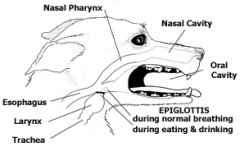
Nasal cavity, sinuses, nasopharynx, larynx
|
|
|
What structures are located in the lower respiratory tract? |
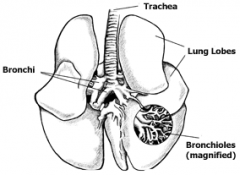
Trachea, Bronchi, Lungs, Pleural Cavity
|
|
|
Name at least 3 diseases that affect the upper respiratory tract. |
Rhinitis, Sinusitis, Epistaxis(nosebleed), Nasal Tumors, Tonsilitis, Laryngitis, Laryngeal Paralysis, Nasopharyngeal Polyps. |
|
|
What is Rhinitis? |
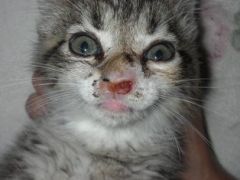
Inflammation, irritation and infection of the nasal cavity. |
|
|
What is the most common cause of Rhinitis? |
Viral infection is the most common cause, bacterial infection is often a common secondary complication. |
|
|
What is chronic rhinitis? What causes it? |
It is a chronic inflammatory disease. Caused by trauma, parasites, foreign bodies, neoplasia(cancer), or mycotic infection. |
|
|
What are three signs of rhinitis? |
Serous, mucoid, or mucopurulent d/c, crusty lesions, respiratory stertor(wheezing), open mouth breathing/dyspnea, sneezing, pawing at nose, coughing/gagging. |
|
|
How would you diagnose rhinitis? |
Clinical signs and hx., culture and sensitivity (typically shows staph), and/or a rhinoscopy. |
|
|
Give 2 ways to treat rhinitis. |
Gently clean the nares (nostrils), apply triple antibiotic ointment, systemic antibiotics, vasoconstrictive drugs and antihistamines (to clear nasal cavity) ex. phenylepherine drops and ephedrine (orally). |
|
|
What is sinusitis? |
Inflammation, irritation and infection of the sinuses. (usually frontal and maxillary) |
|
|
What often causes sinusitis? |
Tooth root abcesses and retrobulbular abcesses. |
|
|
What are 2 signs of sinusitis? |
Swelling under eye or on the side with the bad tooth, unilateral nasal discharge. (it may look like an eye problem at first.) |
|
|
What is one way to diagnose sinusitis? |
Exam, Radiographs, Culture and sensitivity |
|
|
Give a treatment method for sinusitis. |
antibiotics, remove infected teeth, puncture abscess, flush open fistulas. |
|
|
What is epistaxis? |

A fancy word for nosebleed. |
|
|
What are some ways to stop epistaxis? |
Chilled epinepherine (causes vasoconstriction), Apply pressure to nasal cavities, Vitamin K therapy if rodenticide poisoning is suspected. |
|
|
What can cause epistaxis? |
Trauma, foreign bodies, tumors, rodenticide poisoning. |
|
|
What percentage of nasal tumors in dogs is malignant? |
80% in dogs *carcinomas are most common |
|
|
What percentage of nasal tumors in cats is malignant? |
90% in cats *carcinomas and lymphomas are most common |
|
|
Which facial types in dogs are most likely to get nasal tumors?
Brachycephalic, Mesocephalic, Dolichocephalic |
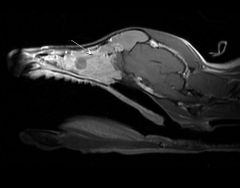
Mesocephalic and dolichocephalic breeds are more likely. |
|
|
Give 2 clinical signs of nasal tumors. |
Facial/oral deformation, unilateral d/c that doesn't respond to therapy (chronic d/c may become unilateral), epistaxis, sneezing, wheezing. |
|
|
How would you diagnose nasal tumors? |

Rule out all other possible causes, radiographs, CT, Rhinoscopy, Biopsy. |
|
|
What are some ways to treat nasal tumors? |
Chemo, Radiation, Surgical removal.
(These are only temporary cures for the symptoms though. Masses generally reoccur.) |
|
|
What is tonsilitis? |
Inflammation, infection of the tonsils. (Common in dogs, rare in cats) |
|
|
What are two clinical signs of tonsilitis? |
Gagging, retching, short soft cough, inaapetence, salivation, dysphagia. |
|
|
Give one way to diagnose tonsilitis. |
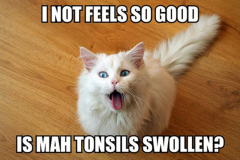
Examination (enlargement of tonsils, tonsils may look red). |
|
|
Give one example of a neoplasia that commonly occurs in canine tonsils. |
lymphosarcoma, milgnant melanoma, squamous cell carcinoma.
Side note: (lymphosarcoma usually results in bilateral symmetric enlargement. Nonlymphoid neoplasia is usually unilateral.) |
|
|
Give a treatment option for tonsilitis. |
Antibiotics, soft/liquid diet, pain relief, anti-inflammatories, surgical removal (chronic infection/neoplasias). |
|
|
What is laryngitis? |
Inflammation, irritation, infection of the larynx. (typically due to excessive noise making) |
|
|
When examining for laryngitis, what would you most likely see? |
Redness and inflammation of the larynx. |
|
|
How would you treat laryngitis? |
restrict noise making, antibiotics (if infection is present), anti-inflammatories(often glucocorticoids) |
|
|
Laryngeal paralysis can be hereditary, what is one breed that is prone to it? |
Bouvier, siberian husky, bulldog, leonberger. |
|
|
What are 3 clinical signs of laryngeal paralysis? |
vocal changes, inspiratory stridor (wheezing on inspiration), standing with head lowered/mouth open, cyanotic mucous membranes, increased pulse rate, hyperthermia, neck extension. |
|
|
Diagnosis for laryngeal paralysis can be done how? |
examination, clinical signs, laryngoscopy |
|
|
What is one way to treat laryngeal paralysis? |

Laryngeal tieback(permanent fix), calm down the patient, oxygen supplementation, corticosteroids, anti-inflammatories, antibiotics, cool them off, tracheostomy. |
|
|
Benign inflammatory growths of connective tissue arising from the mucosal lining of the tympanic bulla, the pharyngeal mucosa, or the auditory tube are called ______. |
Nasopharyngeal polyps. |
|
|
What is a treatment option for nasopharyngeal polyps? |
Surgical removal. (Horner's syndrome is a common complication) |
|
|
Name 3 diseases that affect the lower respiratory tract. |
infectious canine tracheobronchitis, feline bordetella, collapsing trachea, feline asthma, feline heartworm, feline viral rhinotracheitis(herpesvirus), feline calicivirus, fungal diseases, pleural effusion, pulmonary neoplasia. |
|
|
Infectious canine tracheobronchitis is what? |
acute or chronic inflammation of the trachea and bronchial airways. (Kennel cough) |
|
|
The onset of Kennel cough usually occurs how many days after exposure? |
5-10 days |
|
|
Give a clinical sign of kennel cough |
Dry, hacking, honking, paroxysmal(spasmic) cough, may produce small amounts of phlegm, often worse at night. |
|
|
How would you diagnose Kennel cough? |
look at exposure factors, clinical signs, is there a cough produced on tracheal palpation? |
|
|
Kennel cough is self limiting(and highly contagious), however, it may progress to what two other diseases? |
fatal bronchopneumonia(puppies/geriatrics), chronic bronchitis (debilitated adults) |
|
|
How long does it usually take for kennel cough to go away? What are some treatment options that are available? |
2-3 weeks. Glucocorticoids for inflammation (temaril-p, prednisone), antitussives (hydrocodone, butorphanol), bronchial dilators (aminophylline, terbutaline). |
|
|
When giving a vaccine for kennel cough, you would give Bordetella bronchiseptica Intranasally and Bb+parainfluenza by injection. True or false |
False. Bordetella bronchiseptica is an injection Bb+parainfluenze is intranasal. |
|
|
Feline Bordetella infection is self-limiting, however, it can be dangerous to who? |
Young kittens, and severely immunocompromised animals. |
|
|
Give 2 clinical signs of feline bordetella infection. |
fever, sneezing, mucopurulent nasal d/c, submandibular lymphadenopathy, coughing, rales, malaise(just plain not feeling good) |
|
|
Diagnosis for feline Bordetella Infection is made specifically by ______. |
Culture and sensitivity form oropharyngeal swabs. |
|
|
Feline Bordetella Infection is very close to what other two feline infectious diseases? |
Feline calici and herpes viruses. (infectious/contagious between cats, and prevention is best.) |
|
|
When I say that prevention is best for keeping cats healthy, what am I saying? |
Eliminate stress, good hygiene, good nutrition, keep sick cats isolated. |
|
|
A defect in which tracheal rings lose the ability to remain firm and collapse during respiration is called ______. |
Collapsing trachea (this is frequently seen in small and toy breeds, also more susceptible if overweight, or older.) |
|
|
What are 3 clinical signs that an animal may have collapsing trachea? |
Harsh dry honking cough that gets worse during exercise/excitement or wearing a collar/pulling, frequently has concurrent heart disease/chronic bronchitis. |
|
|
How do we diagnose a collapsing trachea? |
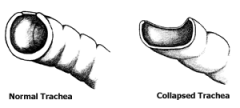
Cough produced on palpation, radiographs (show narrowing of trachea), bronchoscopy, ultrasound, fluoroscopy, rule out all other possible causes. |
|
|
There are several drug treatment options for collapsing trachea, which include anti-tussives, glucocorticoids and bronchial dilators. Can you name one drug from each category? |
Anti-tussives: butorphanol, hydrocodone Glucocorticoids: prednisone bronchial dilators: theopylline, terbutaline |
|
|
What are some other ways that you can reduce incidents of collapsing trachea? |
Weight loss, using a harness, decrease secondhand smoke exposure, manage secondary infections, manage heart disease. |
|
|
To treat an animal during an episode of collapsing trachea, what can you do? |
calm the animal, slow breathing, oxygen therapy(as needed), glucocorticoids (inflammation) |
|
|
When doing surgical treatment for tracheal collapse, what is the treatment aimed at? |
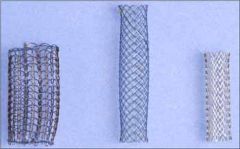
Adding external support for the trachea (stents, or plastic rings for support). |
|
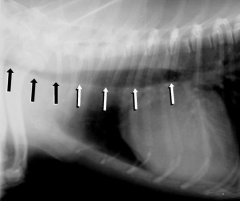
What does this picture show? |
Collapsed trachea |
|
|
Spontaneous bronchoconstriction, airway inflammation, and hyperreactivity can be used to describe this feline lower respiratory disease. |
Feline asthma |
|
|
Give 2 clinical signs of feline asthma. |
Acute onset of dyspnea, cough, wheezing, lethargy, gets worse when it is hot and humid or on high dust/pollen count days. |
|
|
How is feline asthma diagnosed? |
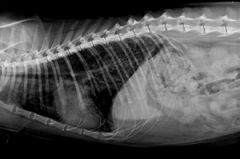
Clinical signs, history, rule out other diseases, radiographs (often show diffuse bronchostitial pattern.) |
|
|
Treatment for feline asthma is usually aimed at alleviating dyspnea and controlling inflammation, give me an example of a high-dose/long-term corticosteroid for inflammation, and a bronchodilator. |
Corticosteroid: Prednisone, Depo-Medrol. Bronchodilator: Terbutaline, Cyproheptadine |
|
|
Name two oral inhaled medications that are used at home to treat feline asthma. (Maintenance and rescue med) |
Maintenance: Flovent (fluticasone) Rescue Med: Albuterol |
|
|
How would you go about alleviating your cats symptoms for feline asthma (at home)? |
Decrease allergen exposure, aggressive treatment(acute attacks), air-conditioners/purifiers, nebulizers. |
|
|
What is HARD? |
Heartworm Associated Respiratory Disease |
|
|
What are 3 clinical signs of heartworm? |
cough, dyspnea, wt. loss, anorexia, lethargy, tachycardia, occasional CNS, often presents as an acute asthma attack. |
|
|
Why is it hard to diagnose HARD? |
ELISA tests show past exposure as well as active infection (doesn't differentiate), Antigen tests are difficult because there is usually a low worm burden and they're all males. |
|
|
Is there an approved treatment for heartworm right now? |
No. But you can use things like Interceptor, Heartgard for cats, and revolution for prevention options. Also, supportive care includes, cage rest, bronchodilators, and steroids(inflammation). |
|
|
Feline Viral Rhinotracheitis is also called what? |
Feline herpesvirus (FHV) |
|
|
Feline Herpesvirus has a high morbidity/low mortality rate, and is hard to inactivate in the environment. True or False. |
False. high morbidity/moderate mortality, easy to inactivate in the environment. |
|
|
Give the clinical signs of Feline Viral Rhinotracheitis. |
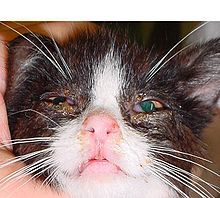
Acute onset of sneezing, severe conjunctivitis, purulent rhinitis, fever, depression, anorexia, ulcers on nose, excessive drooling, corneal ulcers, spontaneous abortion. |
|
|
Treatment for Feline Rhinotrachitis (feline herpesvirus) is aimed at what? |
Supportive care: fluids, electrolytes, BSA's, Steam/vaporization/nebulization, clean eyes/nose, feeding, decrease stress, lysine. |
|
|
What is one thing that interferes with viral replication of feline herpesvirus(feline viral rhinotracheitis)? |
Lysine (shortens episodes), also there is chronic-intermittent shedding during times of stress, so keep stress free. *The virus is easily killed by disinfectants. |
|
|
What is your best defense when treating feline viral rhinotracheitis(feline herpesvirus)? |
Good vaccination protocol. |
|
|
Feline Calicivirus has high morbidity/low mortality.
True or False |
True |
|
|
Where does the feline calicivirus replicate? |
Oral and resp. tract epithelium |
|
|
Where is feline calicivirus secreted? |
saliva, feces, urine, and respiratory. (very hard to kill with disinfectants, and spread by direct contact/fomites). |
|
|
What are 2 clinical signs of feline calicivirus? |

Oral ulcers, increased salivation, pneumonia, acute arthritis, diarrhea, fever, serous ocular/nasal d/c, mild to moderate conjunctivitis. |
|
|
Treatment for calicivirus is aimed at ______care. |
Supportive care: fluids, keeping eyes/nose clean, BSA's, Feeding, oxygen (as needed), vaporizers, nebulizers, steam therapy. |
|
|
Vaccination for Calicivirus will prevent the animal from getting the disease.
True or False |
False. Doesn't guarantee immunity, but will limit the severity. |
|
|
How long do the clinical signs for calici virus usually last? |
5-7 days (anorexia/ulcers can last longer) |
|
|
What is the mortality rate for Virulent Systemic Feline Calicivirus (VS-FCV)? |
~65% (symptoms include d/c from eyes/nose, mouth ulcers, jaundice, mult. organ dysfunction syndrome, fever, lethargy, anorexia, edema of limbs/face. |
|
|
What are the 4 most common fungal diseases in animals? |
Blastomycosis, Coccidiomycosis, Histoplasmosis, Aspergillosis. |
|
|
Blastomycosis is caused by what? |
Blastomyces dermatitidis (Mid-US) Incubation period=5-12 weeks, 3 clinical forms. |
|

What is shown here? |
blastomycosis |
|
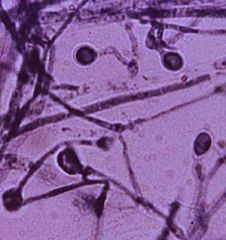
What is this? |
blastomycosis |
|
|
What are 2 clinical signs of blastomycosis? |
Lymphadenopathy, Wound exudates, ocular/nasal d/c, dyspnea, cough, fever, wt. loss, depression, anorexia. |
|
|
How is diagnosis usually made for blastomycosis? |
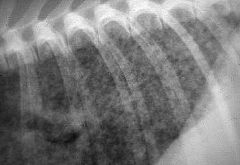
lack of response to therapy, CBC, chem, Hypercalcemia, aspirates/smears, radiographs. |
|
|
What is used to treat blastomycosis? |
Amphotericin B (most effective), Ketoconazole, Itraconazole |
|
|
Coccidiomycosis is caused by what? |
Coccidioides immitis (sandy soils/mild winters: AZ, NM, TX) Can enter blood and lymphatic system and cause systemis dz. |
|
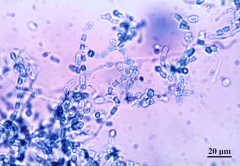
What is this? |
Coccidiomycosis |
|
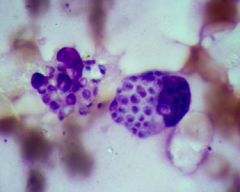
What is this? |
Coccidiomycosis |
|
|
What are 3 clinical signs of coccidiomycosis? |
Mild cough, Low fever, anorexia, wt. loss, weakness/depression, lameness/swelling/pain, lympadenopathy(enlarged lymph nodes), myocarditis, skin lesions, CNS |
|
|
How would you diagnose Coccidiomyosis? |
CBC, Chem, cytology, biopsy, radiographs, serology |
|
|
How long is treatment required for coccidiomycosis? What is used? |
6-12 months, Itraconazole, Ketoconazole |
|
|
What causes Cryptococcosis? |

Cryptococcus neoformans. (most common fungal dz in cats) |
|
|
Where is Cryptococcus neoformans typically found? |
In bird poop. |
|
|
What are 2 clinical signs of cryptococcsis? |
Feline: nasal cavity/sinus lesions, chronic nasal d/c, nasal granulomas, lymphadenopathy, CNS, eye lesios, fever, wt. loss/anorexia. Canine: CNS primarily, skin lesions. |
|
|
How do you treat cryptococcosis? |
Amphotericin B, 5-Flucytosine, Ketoconazole, Itraconazole. (For 2 months or longer). |
|
|
Histoplasmosis is caused by what? |
Histoplasma casulatum (OH, MS, MI) found in soil, bird/bat droppings. signs develop in 12-16 days. |
|

What is this? |
Histoplasmosis |
|
|
What 2 places would you most likely see clinical signs with Histoplasmosis? |
Pulmonary and GI |
|
|
What are some pulmonary signs you may see with Histoplasmosis? |
pale MM, dyspnea, hepatomegaly, lymphadenopathy, ocular lesions, nasopharyngeal ulcers, wt. loss, fever, anorexia. |
|
|
What are some GI signs seen with histoplasmosis? |
Lg Bowel diarrhea, pale mm, ascites, hepatomegaly, wt. loss, low fever, depression, anorexia. |
|
|
What would you do to diagnose Histoplasmosis? |
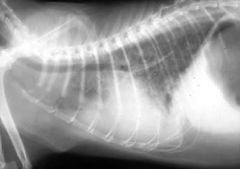
CBC, Cytology/Histo, Radiographs(show diffuse or linear pulmonary pattern). |
|
|
What is the treatment for Histoplasmosis? |
Itraconazole, Ketaconazole. (Prognosis is good for pulmonary form, guarded for systemic) |
|
|
Aspergilliosis is caused by what? |
Aspergillus fumigatus (found in decaying areas: compost, moldy seeds/grain, sewage). |
|

What is this? |
Aspergillosis |
|
|
What can aspergillosis cause in felines? |
Abnormal function of liver, GI, lung, spleen, kidney, lethargy, fever, wt. loss, anorexia. |
|
|
What can aspergillosis cause in canines? |
Nasal lesions, sangopurulent nasal d/c, sneezing, stertor, facial pain, ulcerated nares. |
|
|
What breed most often sees aspergillosis? |
German Shepherds |
|
|
In canines, aspergillosis can occur as localized, systemic, or generalized infections.
True or False |
True |
|
|
What is 1 way to diagnose aspergillosis? |
Radiographs, biopsy/endoscopy. |
|
|
If aspergillosis is localized, it is a grave prognosis, however, if it is systemic, it is an OK prognosis.
True or False |
False. Localized infection=OK prognosis, systemic infection=grave prognosis |
|
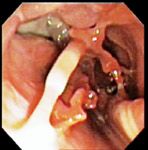
What type of infection is this? |
Aspergillosis |
|
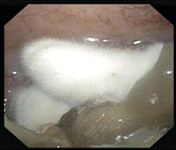
What type of infection is this? |
Aspergillosis |
|
|
What type of treatment can you give for Aspergillosis? |
Topical clotrimazole BID up nasal cavity w/ catheter. For systemic infections: Fluconazole, Itraconazole, Ketoconazole. |
|
|
Fluid accumulated in the pleural cavity is ______. |
Pleural effusion |
|
|
What are some diseases that are associated with pleural effusion? |
CHF (right sided), Intrathoracic neoplasia, Pyothorax, Chylothorax. |
|
|
What are some clinical findings of pleural effusion? |
respiratory distress,dyspnea, cough, circulatory compromise. |
|
|
How would you diagnose for pleural effusion? |
PE/clinical findings, thoracocentesis, radiographs |
|
|
What would a rad of a chest with pleural effusion most likely show? |
unilateral or bilateral fluid accumulation. |
|

What is this radiograph showing? |
Pleural effusion |
|
|
Treatment depends on the cause: 1. CHF 2. Neoplasia 3. Pyothorax 4. Chylothorax
A. Tube thoracostomy to drain purulent material, Abx, Long term tx, clindamycin, ampicillin,chloramphenicol. B. Chemo and therapeutic thoracocentesis C. Treat underlying heart disease and thoracocentesis as needed (relieve dyspnea) D. Therapeutic thoracocentesis |
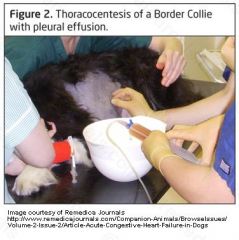
1.) C 2.) B 3.) A 4.) D |
|

What procedure is being done to this cat? |
Thoracocentesis |
|
|
Pulmonary Neoplasia occurs most often in animals of what age? |
9-12 y/o. |
|
|
Primary lung tumors that occur w/ pulmonary neoplasia are uncommon.
True or False |
True. (they usually metastisize to other areas; lymph nodes,bone, brain, other organs) 70-80% adenocarcinoma |
|
|
What are some clinical signs of pulmonary neoplasia? |
Cough, exercise intolerance, wt. loss, poor body condition, dysphagia, vomiting, anorexia, dyspnea/resp. distress, pleural effusion (more common in cats). |
|
|
How would you diagnose pulmonary neoplasia? |
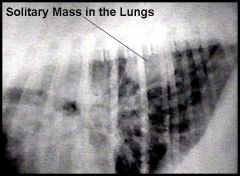
Thoracic rads, Biopsy/cytology |
|
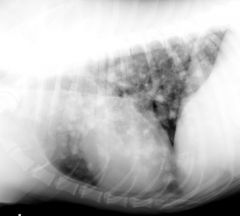
What does this picture show? |
Pulmonary neoplasia |
|
|
How would you treat pulmonary neoplasia? |
Surgical excision/lobectomy (for single mass), chemotherapy (decrease size, not lengthen survival time), surgical excision of primary tumor is required. |
|
|
When pulmonary neoplasias are diagnosed, what stage are they usually? |
Late stage |
|
|
Pulmonary neoplasia is the most untreatable disease of the lungs, and recurrence or metastasis is a common cause of death.
True or False |
True |

